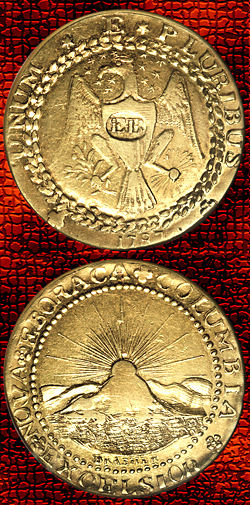|
"Making Cents"
The Signal
Saturday, September 30, 2006
| A |
It is believed that these Lima-type doubloons were made in 1786 by Brasher, a New York City goldsmith and jeweler. Only two such pieces are known today, although he may have made others. The TenEyck specimen was sold in January 2005 for $690,000. The other specimen is known by one of its owners, the Newcomer specimen.
The more familiar American or New York-styled doubloons were dated 1787. They feature a heraldic eagle on the reverse with a shield on its chest, clutching an olive branch in one of its talons and a bunch of arrows in the other. This iconic symbol was later modified for many of our early coinage issues. Around the edge, separated by a wreath, was the motto "E Pluribus Unum" and the date, 1787, below.
Each piece was counterstamped with the "EB" hallmark on the eagle's wing, except the first specimen, where the punch was on the shield on the eagle's breast. This is also known as the Bushnell specimen and was sold tin 2005 for $2.99 million. It was on display at the recent ANA convention in Denver.
A half doubloon is also known; in fact, only one specimen exists. It is known as the Smithsonian specimen. The front design consists of the seal of New York (state), featuring a rising sun over a mountain peak with the mottos, "Excelsior" and "Nova Eborac" (New York) around the edge. The name "Brasher" appears in tiny letters under the mountain scene.
Only eight of the New York-styled doubloons are known today, although chances are, Brasher made more than eight. None has been discovered in well over 100 years, so it is safe to assume the chances of others surfacing is slim to none. At the same 2005 sale, another specimen with the "EB" punch on the wing brought $2.415 million.
Brasher got the job as an assayer before federal coinage was released. He tested and verified the weight and gold content of various foreign gold coins that circulated in New York's busy commercial center. Coins that met his specifications were stamped with his hallmark "EB" punch. Today, such coins are worth tens of thousands of dollars and more, depending on their condition, size and date.
Brasher also made silver settings, and each piece bore his hallmark. Today a single spoon or fork with the "EB" hallmark can bring hundreds of dollars at auction.
The purpose of Brasher's gold doubloons is uncertain, since he did not submit them to the new Mint or the Treasury for consideration as designs for new United States coins. They also had a value of 15 dollars in Spanish reales — which was not in the plan for our coinage. At the time, the highest planned coin was the gold eagle, with a value of $10.
If the Brasher pieces ever were used in commerce, they can be classified as privately minted coinage or even tokens. Today there are 10 known Brasher doubloons, two Lima types, one half-doubloon of the New York style and seven New York-style gold doubloons.
Naturally, with auction prices setting new records each time they come up for sale, chances are that only the richest collectors can ever consider owning one of these fabulous pieces.
Dr. Sol Taylor of Sherman Oaks is president of the Society of Lincoln Cent Collectors and author of The Standard Guide to the Lincoln Cent. Click here for ordering information.
©2006, THE SIGNAL · ALL RIGHTS RESERVED.

![[Most Recent Quotes from www.kitco.com]](http://www.kitconet.com/images/quotes_special.gif)

